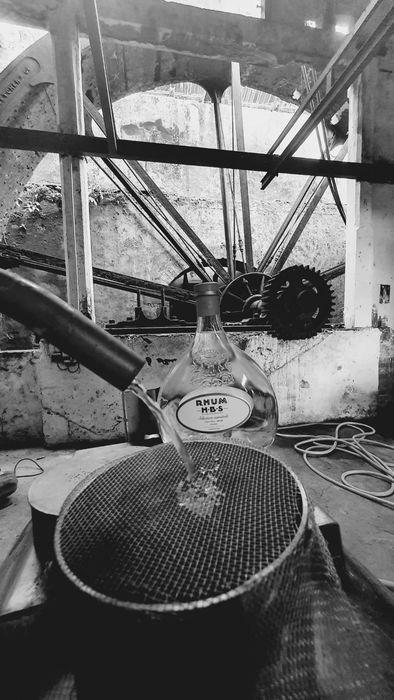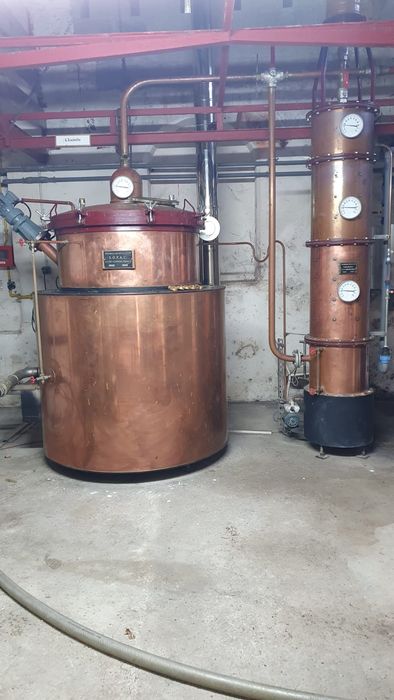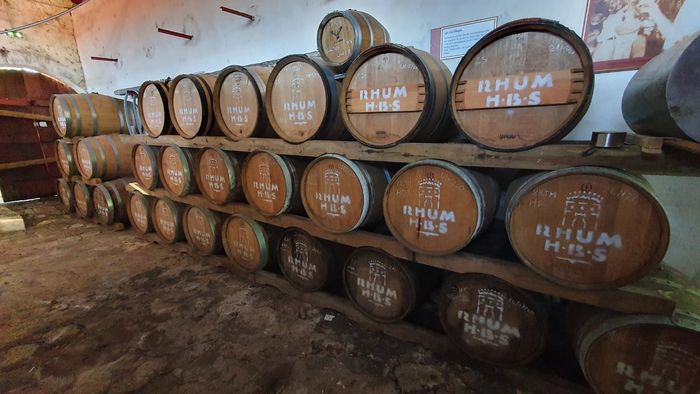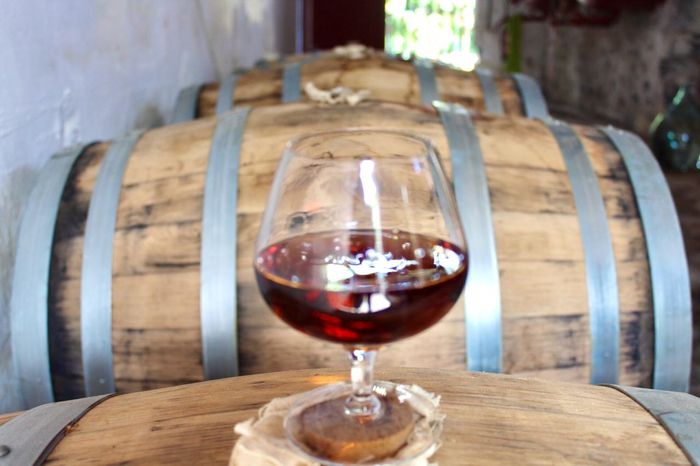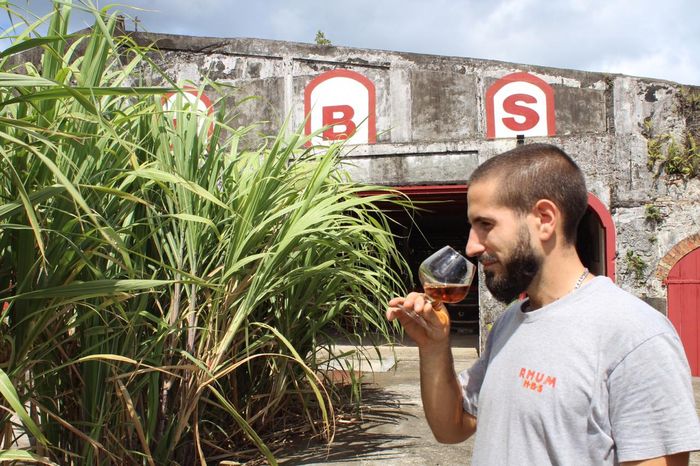
Let's pick up our interview about Habitation Beauséjour where we left off, and focus in more detail on cane, fermentation, distillation, reduction, with Karl Agostini, distiller and cellar master. You can find the first part by following this link .
So far, the HBS vintages that have been released have come from a single batch?
The Cuvée du Sénateur was a single batch, like everything else, except the 2020 vintage which was made up of 2 batches, with 2 canes harvested at two different times.
Your plots at Habitation Beauséjour are planted at different altitudes, what does that represent in terms of results from a cane perspective?
This mainly changes the sugar level, again depending on the period. If it is Lent, on the highest plot, it will be a little less hot because there is more air circulating, so the sugar level will be slightly lower. If it is in the basin, during the rainy season, all the water will gully and the sugar level will decrease.
There are altitude differences, between 100 and 150 meters, so it's not that big of a difference. It's more the exposure to the sun and the water that gullies that will play a role. Right now, we're in the cyclone period where we're supposed to have a lot of rain, except that we don't have any, and we have a lot of heat. We can imagine that the sugar level (brix) is quite high on all of our plots.
It's hard to predict, but that's also what's fun. One week you can have beautiful sunshine, and a plot with a brix ( unit of measurement of sugar content, editor's note ) of 14, 15, 16, sometimes up to 19; and the next week, because it rained, you find yourself on the same plot with a brix of 10 or 11. You have to play with that. You can change plots, or stay on the same one and have a rum that will be completely different.
When a cane is less sweet, do we adapt the fermentation, extend it to get a little more out of it?
For each juice that we press each day, we adapt the recipe. We don't have a precise recipe, which says that on such a plot, we will put so much yeast etc. We crush our juice, we take our measurements and we adapt our recipe accordingly.
Do you grow mostly blue cane?
Yes, we have 70 to 80% blue cane B69 566. Some plots of Habitation Beauséjour were planted well before we restarted the distillery, and sometimes there was a little red cane or black cane. We sometimes end up with plots where there are several varieties. The big agricultural work that we are doing at the moment is to replant the fields while being almost certain of the variety that will come out of it, even if it is almost impossible not to have a red or black cane lying around in the lot.
In December/January, we just planted a whole plot with a "forgotten" cane. It is a cane that was very present in Martinique , but which was forgotten because it was very big and tender, so the rats had a field day with it. We replanted it on a not very big plot, because it allows us to control the pests, and have the least possible losses.
Today, blue cane is very present on the island, because it is a cane that gives a lot of juice, which is very sweet, and which is also resistant to certain pests because it is a little harder. With our slightly smaller plots, we can afford to see what can be done next door, to get off the beaten track. It is really exploration from start to finish, whether in the field or at the distillery, so it is very good.
If it was planted at the beginning of the year, how long is it estimated to be before it can be harvested?
It takes about 7 to 9 months, depending on the weather conditions. I think we will harvest it in December or January.
How many people work at Habitation Beauséjour?
There are about ten of us, with 2 cane cutters, 1 crusher, myself who is the distiller and cellar master, and other people who take care of bottling, labeling, who lend a hand here and there, and then people who maintain the plots.
Is the shape of the HBS bottle something historical, or something you designed according to your taste?
It was Arthur De Lucy who chose this bottle, at the time of the creation of the distillery. The choice was above all to stand out on the shelves, therefore a commercial argument, and then also aesthetic, since it looks like a mini demijohn.
Can you tell us about your still, a model that is not very common in the industry?
We are the second in Martinique to have a still, after A1710 . It is a Charentais still that can hold 880 liters, with a rectification column and a condenser. At the time, we only had the still and the condenser, we produced 35% alcohol. Since then, we have invented the rectification column, which allows us to rectify the alcohol content. At HBS, we are on a 9-tray column. Everything is made of copper, which is important because copper is a catalyst.
Our still is called "l'Isabelle". It is a wonderful tool that gives an authentic taste to the rum. This is something that some people forget, saying that our rum is strange and does not have the same taste. They are simply used to column rums. Some people get stuck with the AOC ( which imposes the distillation column, editor's note ). It is true that it is great, it is what has made Martinique rum one of the best rums in the world. In our way of making rum, we get as close as possible to the specifications of the AOC. But as soon as there is a point that interests us a little less, we move on.
It is interesting for us to make a rum that differs from the AOC Martinique , but which is very close to it in terms of the qualitative base. We cannot afford to do quantitative. Already because it does not interest us, we are an artisanal distillery. We prefer to produce less, but to produce something good, rather than release thousands of bottles and not have it please. We are truly artisans.
Sometimes the AOC is misinterpreted by the public, who see it as a medal, and not as a benchmark, a precise rum profile, obtained using structured methods. People would thus tend to believe that what is not AOC would necessarily be of inferior quality…
There are two types of customers: those who are fans of rum and who know the differences, AOC, non-AOC, molasses, etc. And then there are those who are starting to take an interest in it, following this craze around rum that we were talking about earlier. They will refer to the AOC Martinique, because it is something that we see on good products. Except that there is a lack of information among the population, and fashion should perhaps start there.
There is a lack of communication. Or at least, communication is not being done with the right people. So there are amalgams that are being made, as you say, and some people say that those who are not AOC are those who did not pass the exam. It's a bit of a shame. It's like molasses rum , many people spit on it even though there are some very good ones.
It's up to the wine merchants and retailers, but also the distilleries, to do this work. When I receive people at the distillery who tell me "but you're not AOC", I tell them "taste it, and then we'll talk about it again". It's part of our job, and it's a discussion I like to have with people. I like them to leave the distillery saying to themselves "it's not AOC but it's still not bad!" (laughs)
Can you go back over everything that is rest, reduction, mixing etc?
We are on short fermentations, 24-48 hours. Generally, we are more around 30-48 hours. The distillation is done in about 4 hours. We let the rum rest in stainless steel tanks for a night before sending it to the cellar, in the reduction tanks. It is done with spring water from Mount Pelée. It is very long, since it lasts 7 or 8 months, or even more for the next ones, especially with a brewing every week.
This is done with a pump, or simply with a stick, to homogenize the rum as much as possible, to make the right mix with water, etc. The reduction is minimal, with very little water every 3, 4 or 5 weeks, so as not to break the product. If you add too much water, it is the same as putting an ice cube in a punch. The rum becomes cloudy and you dilute it more than anything else.
You are right to talk about fermentation, it is a subject that we had not really discussed...
The crushed canes are those cut that day. With our mill, we extract between 70 and 80% of the juice, and we only do one pass. Some will say that we are wasting it. But on the one hand it saves time, and above all we recover the first juice, the real good juice. The one that wants to stay in the cane is not the juice we want (laughs). If we wanted to do a second pass, we would have to add water, which would dilute our juice. Since we are veiling a truly perfect product, we do not want to add water at this point.
The bagasse that we collect is taken to the fields, to add biomass, cover and improve the soil. For the juice, we add a little bit of water to obtain the liter that interests us and to vary the brix when it is too high. We then add our yeasts and all our ingredients, for a fermentation between 24 and 48 hours.
“We work with dry yeasts, but also with mother tanks.”
This allows for fermentations to start more quickly, but also to reduce the amount of dry yeast to add. At first, we only used dry yeasts. But there was a taste that bothered us. So we started working with mother tanks, and the taste improved considerably. We saw a real difference during fermentation. Before, we were on small fizzes on the surface. Later, we arrived on big bubbles, with the must overflowing from the tank. It was a whole mess, but at least we had good fermentations. And the next day, when I arrived, the density being below 1000, I could start my distillation, it was perfect.
This is part of the levers we are working on, to change our recipes, and therefore our rum. This is what I tell people: when I arrive at the distillery, I am one third cook, one third sorcerer, one third distiller (laughs). There are so many levers that can be activated during fermentation, distillation, reduction, etc. In the end, it's full of experiments, and it's great.
Do you already have things aging?
We already have 27 full barrels of rum aging. Our oldest date from April 2020, so they are already 1 and a half years old. We could already release them in wood-aged. Except that we don't want to. We prefer to release our old before releasing the wood-aged. We don't want to disappoint our customers, or ourselves, so we don't want to go too fast. Today, we like it, but after 3 years it will be even better.
These are products that are already very interesting. For some, we know that we will release them after 3 years, for others, 5 or 10 years. And for others that are a little less good, we will forget them in a corner of the cellar. Either they will be used for blending, or they will improve over time.
Once again, we are very young, so we do not yet have all the keys to manage aging. This is also the subject of the next training that I will follow. So we experiment, in terms of the alcohol content at which we will put the rum in the barrel, which rum we will put in the barrel, which barrel, which toast, which finish… There are lots of things like that. We are not in a distillery, but in a laboratory, in the lair of a mad scientist (laughs).
What types of barrels are you currently working with?
We have different types of barrels, since we experiment a lot, as I was telling you. We have old cognac barrels, old whisky barrels, Burgundy barrels… I am a big fan of HSE La Tour Blanche, finish Sauternes. So for me it was unthinkable not to have Sauternes barrels in the cellar, something that is now done. We have old barrels that we recovered from JM. They were used for the Fumée Volcanique cuvée, so with a very strong toast. And then we have new barrels, which allow us to store our rums for a few months. They take on a beautiful color, and we then transfer them to another barrel.
This always allows you to experiment. For example, we put a rum in a new barrel for 3 months. Then we put it in an old cognac barrel. And then next to that, we put our rum directly in an old cognac barrel. We can clearly see the difference in color depending on the years, the difference in taste, and this allows us to see what we like best.
Once again, we are very young, I am a young distiller who knew nothing about rum. Even today, compared to Marc Sassier or Karine Lassalle, I am very small and I do not even dare to call myself a cellar master.
Considering the first rums released, this youth is not necessarily felt!
We had a lot of help, with different publications and talking to other distillers, so we discovered some things. And then as we were saying, sometimes a lever that we have lifted allows us to go in a good direction. Or on the contrary, it tells us that it is to be forgotten. So we show you the good things but there were some very bad ones too! (laughs).
